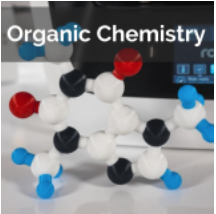
Organic and Biochemistry
The comprehensive contents from this book, combined with Odigia’s Teaching and Learning Tools have everything you need to engage, collaborate, track and assess your students.
Helping Teachers Do What They Do Best: Teach

Customize
Use our courses as is or easily customize them to fit your teaching style and the needs of your students. You can add your favorite resources, hide and show our existing content and pre-built assessments, or make them your own. Everything your students need, in one place!

Engage and Collaborate
Odigia combines learning materials, discussions, and tools to create a familiar social experience for students allowing you to easily connect and redirect students attention.

Track
See how much time students are spending on different areas of the course, which areas are creating the most amount of engagement and identify topics the students are struggling with. Flag and provide feedback on assignments to proactively meet individual students' needs.

Assess
Game theory allows students to monitor their progress visually and motivates them to stay on track. Students can see exactly what activities they need to complete, which ones have been flagged and compare their progress against the overall class.
Organic and Biochemistry Course Outline
What Is Organic Chemistry? How Can Organic Compounds Be Identified? What Are the Properties Of Simple Organic Compounds?
- What is Organic Chemistry?
- How do you determine names and formulas of alkanes?
- What are the properties of alkanes?
- What are other forms of alkanes?
What Are Unsaturated Hydrocarbons? What Are Aromatic Hydrocarbons?
- How do you determine names and formulas of alkenes? What are isomers?
- What are the properties of alkenes? How are polymers formed?
- What are other forms of unsaturated hydrocarbons?
What Types Of Organic Compounds Contain Oxygen? What Are Functional Groups?
- What are functional groups?
- How do you determine names and formulas of alcohols? What are the properties of alcohols?
- How are alcohols formed? How do alcohols react with other substances?
- What compounds are derivatives of alcohol?
- What types of compounds contain a carbonyl group? What are the properties and reactions of aldehydes and ketones?
Click here to learn more
- What are other functional groups that contain oxygen and nitrogen?
- How do you determine names and formulas of carboxylic acids? How are carboxylic acids formed?
- What are the physical and chemical properties of carboxylic acids?
- How do you determine names and formulas of esters? What are the properties of esters?
- How are esters formed? What are the reactions of esters?
What Are Organic Bases? What Are The Structures And Properties Of These Compounds?
- How do you determine the names and formulas of amines? What are the properties of amines?
- What compounds are derivatives of amines? How do you determine the names and formulas of amides? What are the properties of amides?
- How are amides formed? What are the reactions of amides?
- What is the role of amines in the nervous system? What are neurotransmitters?
What Are Carbohydrates? How Does The Structure Vary In Different Types Of Carbohydrates?
- What are the classes of carbohydrates? Which carbohydrates are important to us?
- What are the structures and properties of monosaccharides?
- What are other types of carbohydrates?
What Are Lipids? What Is The Function Of Lipids In The Body?
- What are lipids? How are they classified?
- What types of lipids contain fatty acids? What are their physical and chemical properties?
- How do steroids differ from other lipids? What are the biological functions of steroids?
- What is the importance of lipids in cell membranes? How are substances transported across a membrane?
What Are Amino Acids? How Do Amino Acids Form Proteins?
- What are the properties and reactions of amino acids?
- How are amino acids joined to form peptides and proteins?
What Are Enzymes? How Are Enzymes Regulated?
- What is the function of an enzyme?
- What factors affect enzyme activity?
- What is an inhibitor? How do inhibitors regulate enzyme activity?
- What is an enzyme cofactor?
What Are Nucleic Acids? How is Genetic Information Expressed?
- What are genes? What are the components of nucleotides?
- What are nucleic acids and how are they formed? What type of structure exists in nucleic acids?
- How is nucleic acid replicated? How is RNA created from DNA? What are the types and functions of RNA?
- How is nucleic acid the genetic code for protein? How is protein synthesized?
- What are nucleic acid mutations and how do they affect the body? What are viruses?
How Does The Body Generate Energy? How Are Carbohydrates Metabolized?
- What is metabolism? How does it produce energy?
- What are the three stages of catabolism? Where do these reactions take place in the cell?
- How are carbohydrates, proteins, and lipids digested?
- How are carbohydrates further catabolized to produce energy in Stage II and III?
- How is glucose stored in the body? How is glycogen and glucose metabolism regulated?
Combine this content with our customizable, at-home Chemistry Lab kits from eScience Labs to create a complete digital learning experience for your students.
Organic and Biochemistry provides a survey of major functional classes of compounds in organic and biochemistry. Topics include structure, properties, and reactions of the major organic and biological molecules and basic principles of metabolism.
About the authors:
Senior Contributing Authors
Kirsten Williford, Forsyth Technical Community College

